Table of contents
Why is the peanut not a nut? The peanut ( Arachis hypogaea ) is botanically a legume (Fabaceae or Leguminosae) and has a high calorie content, mainly due to protein and fat. Despite belonging to the legume family, peanuts can be eaten raw - but are very rarely sold raw! 1
Use in the kitchen:
Peanuts in their shells are usually roasted. See the text on roasted peanuts here . If you buy them in their shells, they are easy to break by hand. Peanuts are often available without their shells, with or without the purple-brown skin. Fresh peanuts are probably not available, at least in Europe. In the best case, they are dried without high heat, e.g. in the sun. This also applies to wild peanuts or organic peanuts as raw food from controlled organic cultivation.
Raw peanuts have a similar taste to peas or beans , but have the disadvantage that the phytate they contain binds minerals. When dried, they have a more intense taste and are also less susceptible to mold and the formation of aflatoxin, which is carcinogenic. Dried peanuts can be eaten raw, but due to the unfavorable ingredients, you should be very cautious.
Peanuts are a popular ingredient in Asian stir-fries, sauces and curries. The food industry uses peanuts in some sweets, but they are mainly used as a main ingredient in peanut butter and peanut oil .
Vegan recipes with peanuts:
Vegan peanut recipe with good health value: Christmas salad with beetroot, rocket, orange and jicama .
Vegan recipe with few peanuts but high enjoyment value: Homemade "Yolos" (caramel pralines) with Medjol dates .
Vegan recipes with peanuts can be found under the note: " Recipes that have the most of this ingredient ".
| Not only vegans or vegetarians should read this: Vegans often eat unhealthily. Avoidable nutritional mistakes . |
Shopping - where to buy peanuts?
At major retailers such as Coop , Migros , Denner , Volg , Spar , Aldi , Lidl , Rewe , Edeka , Hofer etc. you can find fresh, i.e. unroasted and unsalted peanuts (mostly in shell) during the season (in late autumn and throughout the winter). This applies to Western Europe. Roasted and usually additionally salted peanuts can be found all year round.
Organic or even raw peanuts are more likely to be found in health food stores, organic shops, drugstores, organic supermarkets such as Denns and Alnatura , or online. Raw peanuts are usually available without the shell as wild peanuts, which look speckled and are sold shelled. However, blanching is often used to increase their shelf life. Raw peanuts can be treated with toxic fungicides. Because of the usual heating (for drying) or blanching, it is worth doing a germination test to check the quality if you only want to eat raw peanuts.
Found in the wild:
The "fruit in the ground" can now be found in many subtropical and tropical areas and even in Europe. There, Cyprus is a peanut-producing country. See details below.
Correct storage:
Normally cool, dry and dark, but fresh, undried peanuts should be kept in an airy place. However, the chances of getting them are slim. The ideal storage temperature is between 8 and 10 °C. A good cellar can provide this, or a dark corner in a cool pantry - or the refrigerator. To ensure that the oil from the nuts does not absorb other flavors, you should store them sealed. The most important criterion is dryness, however, because otherwise they will mold and taste rancid. How long can you store peanuts? The storage time should ideally not exceed four weeks. Can you freeze peanuts? If you freeze peanuts and keep them in well-sealed, airtight packaging, they will last for up to a year.
Ingredients - nutritional values - calories:
Peanuts are not a superfood, but fat bombs - but at least: At first glance, with 50% fat, the proportion of saturated fatty acids ("only" 6.3 g) is not bad. The sugar content of 4.7 g in the carbohydrates (16 g) is actually good too. 2,100 g cover half of the daily protein requirement - and that in a fairly good composition of the eight "classically essential" amino acids. Unfortunately, 100 g of peanuts contain a full 70% of the daily requirement of fatty acids - and that in a poor composition. Peanut butter with an energy density of 6.2 kcal/g can be directly compared to smoked pork bacon, which has the same density. Not even chocolate or low-fat butter (3.9) reach this density, only oils surpass it with 9 kcal/g, but we eat very little of it.
Cashews and peanuts have a very poor LA:ALA ratio in common. Peanuts have 16 g of the inflammation-promoting omega-6 linoleic acid (LA) and only 0.1 g of the healthy omega-3 alpha-linolenic acid (ALA). So a ratio of 160:1 instead of the 5:1 recommended by the Federal Office of Public Health. Cashews (33/20/48) have 7.8 g LA to 0.06 g ALA, so a ratio of 102:1. See also the ingredient tables below after the text. 2
Nevertheless, you can read on almost every website how healthy peanuts (or cashews) are, because these websites either copy uncritically or want to sell.
Every food has its good ingredients. For example, phosphorus in peanuts: 388 mg/100g. Compared to hemp seeds, unpeeled (1677 mg), wheat bran (1013), chia seeds (860), porcini mushrooms, dried (642), linseed (642) or oats (523), to name just a few, this is rather low. Phosphorus is the mineral most present in peanuts. 2
Example: manganese , the second highest mineral content in peanuts: 188 mg/100g. Compared to unpeeled hemp seeds (700 mg), wheat bran (611), raw cocoa beans (500), celery (440), linseed (392), chia seeds (335). The manganese content of peanuts is therefore also rather low. Nevertheless, manganese is advertised in peanuts. 2
A positive point worth mentioning is the relatively high proportion of L-arginine, which regulates various hormones.Pumpkin seeds have around 5300 mg of arginine per 100 g, peanuts 3460 mg, almonds 2750, pine nuts 2400, lentils 2240, etc.
You can find all the ingredients, the coverage of the daily requirement and comparison values with other ingredients in our nutrient tables. In the article Nutrients explained you will get a detailed insight into the topic.
Health aspects - effects:
Are peanuts healthy or unhealthy? Uncritical consumption of peanuts is problematic. We can only warn: vegans and vegetarians who are wrongly or uninformed generally live worse than normal eaters - and a study is sure to come out that will ruthlessly expose this. (see link in the box above). This would then stop the vegan hype that is so important for animal welfare and the environment and discredit the oriented minority. This has been our fear since 2014! See this link to see what happened with raw food (The Giessen Raw Food Study) .
Recommendations of the Federal Nutrition Commission (EEK) from 2006:
In 2003, the EEK was commissioned by the Federal Office of Public Health ( FOPH ) to adapt the health significance of fats and oils recorded in 1992 to the latest scientific findings. We have described these in more detail for the ingredient olive oil , but here are just the most important points:
Polyunsaturated fatty acids are essential and are divided into two main groups (there are others): linoleic acid and its derivatives as the group of n-6 or omega-6 fatty acids (LA) and α-linolenic acid or alpha-linolenic acid - often just called linolenic acid or ALA for short (omega-3 or n-3) - and its derivatives. The main sources of pro-inflammatory LA are vegetable oils 3 , but also nuts and seeds! The main sources of healthy, anti-inflammatory omega-3 (ALA) are, for example, rapeseed oil , linseed, walnuts and leafy vegetables. 3
Health-conscious people get polyunsaturated fatty acids from linseed , chia seeds , walnuts (tree nuts), macadamia , herbs and leafy vegetables because they have a particularly good LA:ALA ratio. You can find detailed tables for practically all foods under our ingredients, which can also be accessed from the recipe. The recipes also summarize this. For example, Erb-Müesli has the ideal composition in a ratio of 1:1 (LA to ALA).
Direct statement from the EEK: Too high a consumption of n-6 fatty acids can promote thrombosis and inflammation. It is therefore sensible to reduce the ratio of n-6:n-3 to 5:1. The current ratio is currently around 10:1. There is evidence that lowering this ratio can lead to fewer atherosclerotic diseases and reduce inflammatory processes. 3 Atherosclerotic disease (also imprecisely called arteriosclerosis) is the technical term for cardiovascular disease, primarily coronary heart disease - but also applied to vascular disease.
Contrasting program at the "Center for Health" (updated March 27, 2019) - with the title: "Peanuts - superfood for the blood vessels": "Numerous scientific studies have long shown that peanuts - consumed in the right amount - are anything but potential fattening agents." ... "Participants who had high cholesterol levels at the beginning of the study showed a reduced total cholesterol level and reduced LDL cholesterol levels at the end of the study - after four weeks in which they had eaten 56 g of peanuts daily." If you read the FASEB study on this, Adding peanuts to a meal benefits vascular health , it quickly becomes clear how the result was achieved: The Peanut Institute "supported" it. What these 15 test subjects received as an alternative - one with harmful substances, one can assume - is not declared, at least in the abstract. Instead, the center then shows an advertisement for such products and offers courses to become a specialist consultant for holistic health in another advertisement ...
Dangers - Intolerances - Side effects:
Wikipedia on peanut allergy 4 : A representative study in the United States in 2003 found that around 1.2% of the population is allergic to parts of the peanut. This is consistent with other studies. Peanuts have numerous allergens (proteins) known as "Ara h" - see Wikipedia under Peanut allergens.
There are very different, acute symptoms such as (frequent) hives, watery eyes or difficulty breathing. More rarely, serious reactions occur that can even trigger anaphylactic shock. 5
Under poor storage conditions, the mold Aspergillus flavus can appear, which produces toxic aflatoxins. 6 Peanuts also contain lectins, which tend to cause red blood cells to clump together and can cause symptoms if consumed in large quantities. Another problem is the trypsin inhibitors, which hinder protein metabolism in humans. However, these are no longer active after heating. Peanuts accelerate blood clotting. Gout sufferers should note that pulses have a high purine content.
Occurrence - Origin:
The home of the peanut is thought to be in the Andes. The oldest finds of peanuts in earlier human settlements come from Peru. In 2007, remains were found that were 7,840 years old. 7 Previously, parts of peanuts ( Arachis hypogaea ) that were 5,000 years old were found in the Huarmey Valley in Peru. However, Indians had been collecting other types of peanuts for a long time before that - and also cultivated them. Today, peanuts are distributed as oil crops throughout the tropics and subtropics. According to Wikipedia, the main growing areas are West Africa, China, India, North and South America.
China is the largest producer , accounting for around 36% of world production with 17 million tonnes, but the country produces almost exclusively for its own consumption.8 It is followed by India with 9 million tonnes and the USA with 3.2 million tonnes (in 2017). However, the main exporters of peanuts are the USA, Argentina, Sudan, Senegal and Brazil. The exports of these five countries together account for 71% of the total global export of peanuts.
Growing in the garden or as a potted plant:
To grow: Peanut seeds germinate after a few days. However, the peanut plant needs a tropical to subtropical climate to grow. However, a warm living room or greenhouse is sufficient. In midsummer, a sunny, wind-protected balcony is sufficient. The peanut loves loose, sandy soil with a low peat content. At the beginning of growth, the plant needs a lot of water. Towards the end of the growth phase, you should keep the plant dry so that the fruits ripen well.
Animal protection - species protection - environmental impact:
Taken from "umweltnetz-schweiz": The peanut plant needs between 500 and 600 millimetres of rain. If it rains more or is constantly humid, leaf diseases must be combated with chemical agents (e.g. pesticides). If you grow in areas that are too dry, which is often the case, you have to irrigate. Growing and processing peanuts requires around 2800 litres of water per kilogram of peanuts. The cultivation of peanuts in Senegal, Gambia and Nigeria in the 19th century led to a sharp increase in erosion in the Sahel zone, as a study published in the journal Nature shows. The cultivation led to large-scale deforestation. The sometimes patchy vegetation is more susceptible to erosion and leads to more dust from good soil, which winds ultimately carry into the Atlantic.
In addition, pesticides are used to protect the plants from insects, fungi and nematodes and to destroy weeds between the peanut plants. These pesticides either destroy the food sources of birds, mammals and fish or kill them directly. Especially when [...] applied in the form of grains [...], which birds mistake for food, the impact of pesticides on wild animal populations is great. They are often used over large areas by aircraft.
General information:
The peanut ( Arachis hypogaea ) is a plant species in the subfamily Faboideae within the family Fabaceae or Leguminosae. The peanut belongs to the same subfamily as peas and beans, but unlike them it can be eaten raw. The plant forms an annual herb that is 30-50 cm high. After flowering, the lower part of the ovary lengthens to form a long, stalk-like fruit carrier and pushes the section with the ovule about 5 cm into the ground. This is where the peanut develops.
The majority of peanut production is used to extract peanut oil. Peanuts are also used to make soap and paints. Other products include peanut butter and peanut crisps, cosmetics and (in significant quantities) an oil-based feed additive in agricultural livestock farming.
According to the FAO (Food and Agriculture Organization), 47 million tons (weight with shell) of peanuts were produced worldwide in 2017. 1 The harvested crops are dried as soon as possible, with a water content of 40% to 5 to 10%. In warm countries, this is done outdoors, in temperate climates with artificial heat. After drying, the nuts are threshed, broken and, in many cases, shelled.
Synonyms or alternative names:
Ashanthus nut, Arachis nut, Earth acorn, Earth pistachio, Cameroon nut, Spanish nut, Mesocarp nut. 9 The peanut is also known as Mundubi bean. The food encyclopedia lists the following alternative names: Buren nut, Erdbohne, Java nut, Kuru nut, Mandubi nut and Tiger almond. In some Swiss cantons the peanut is known as Spanisches Nüssli.
The Bambara peanut ( Vigna subterranea ), which comes from West Africa and is also known as the earth pea or Angola pea and was formerly also known as the creeping earth borer, is a different fruit, although it only differs in tribe/genus. 10
The English names are peanut, goober, groundnut, ground-nut and monkey nut.
Literature - Sources:
Bibliography - 9 Sources
| 1. | Wikipedia Erdnuss. |
| 2. | USDA (United States Department of Agriculture). |
| 3. | EEK_Bericht_Fette_in_der_Ernährung_2006_DE.pdf |
| 4. | Wikipedia Erdnussallergie. |
| 5. | Hugh A. Sampson: Peanut Allergy. In: The New England Journal of Medicine. Band 346, 2002, S. 1294–1299, doi:10.1056/NEJMcp012667. |
| 6. | Ruth A. Taber, Harry W. Schroeder: Aflatoxin-producing Potential of Isolates of the Aspergillus flavus-oryzae Group from Peanuts (Arachis hypogaea). In: Applied and EnvironmentalMicrobiology. Band 15, Nr. 1, 1967, S. 140–144. |
| 7. | T. D. Dillehay, J. Rossen, T. C. Andres, D. E. Williams: Preceramic adoption of peanut, squash, and cotton in northern Peru. In: Science. 316(5833), 2007, S. 1890–1893. doi:10.1126/science.1141395. |
| 9. | Reinhard Lieberei, Christoph Reisdorff, Wolfgang Franke (Begründer): Nutzpflanzen. 8. Auflage, Thieme, Stuttgart/ New York, 2012. |
| 10. | Wikipedia Bambara-Erdnuss. |

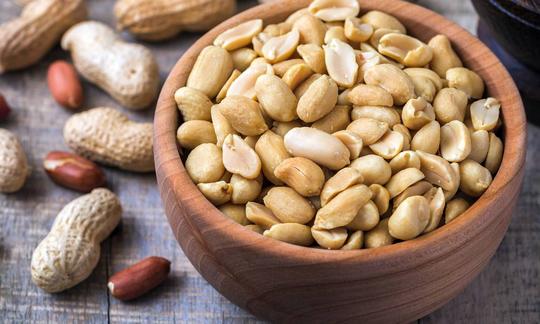

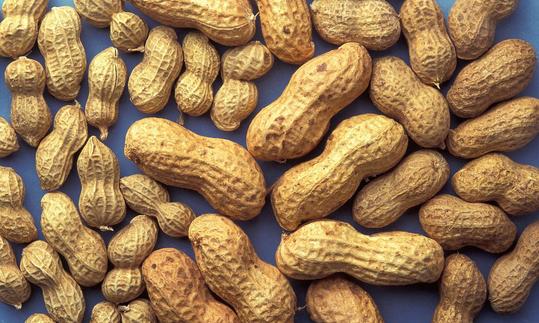

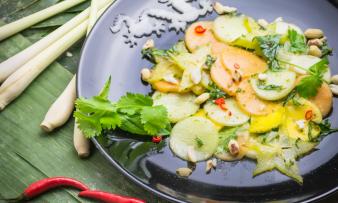
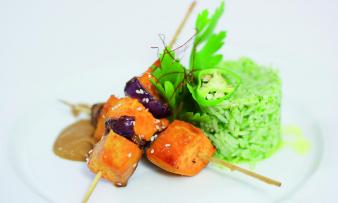
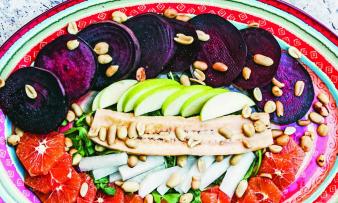





Comments